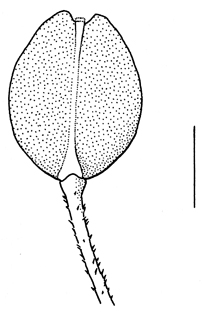Lepidium densiflorum Schrad. (incl. L. neglectum Thell.) (N-Am.) – A rare but probably overlooked, locally naturalised and increasing alien. Apparently first collected on an unloading quay in Wilsele in 1886, than in 1903 in Angleur. Subsequently recorded in several different locations throughout the country but long confused with the very similar Lepidium virginicum (Duvigneaud & Lambinon 1975). Mostly naturalised in urban habitats, for instance in Antwerpen-Linkeroever (already recorded in abundance here in the 1940’s and 1950’s), Brugge, Brussel,… Doubtlessly overlooked elsewhere but definitely much less frequent than Lepidium virginicum. Lepidium densiflorum usually grows in dry, often stony, sun-exposed places: cracks in pavement, foot of walls, railway tracks, sandy roadsides or waste land. The vector of introduction is often obscure although at least part of the records are obviously associated with grain importation. Lepidium densiflorum is still frequently seen on unloading quays for cereals, for instance in the port of Gent.
Lepidium densiflorum belongs to a taxonomically difficult group that further includes L. virginicum and L. neglectum. Especially the latter is poorly distinguished (see Duvigneaud & Lambinon 1975 and Lambinon & al. 2004 for its separation) and here included in Lepidium densiflorum. This is in accordance with current American taxonomists (Al-Shehbaz & Gaskin 2010).
 |
 |
 |
Selected literature:
Al-Shehbaz I.A. & Gaskin J.F. (2010) Lepidium. In: Flora of North America Editorial Committee (eds.), Flora of North America, vol. 7. Oxford University Press, New York-Oxford: 570-595.
Duvigneaud J. & Lambinon J. (1975) Le groupe de Lepidium ruderale en Belgique et dans quelques régions voisines. Dumortiera 5: 20-26.
Feder J. (2003) Die Dichtblütige Kresse (Lepidium densiflorum Schrad.) im Landkreis Gifhorn wiedergefunden. Floristische Notizen aus der Lüneburger Heide 11: 7-9. [available online at: http://www.kaiser-alw.de/pdf/Fl11_03.pdf]
Lambinon J., Delvosalle L., Duvigneaud J. (avec coll. Geerinck D., Lebeau J., Schumacker R. & Vannerom H.) (2004) Nouvelle Flore de la Belgique, du Grand-Duché de Luxembourg, du Nord de la France et des Régions voisines (Ptéridophytes et Spermatophytes). Cinquième édition. Jardin botanique national de Belgique, Meise: CXXX + 1167 p.
Meissner H. (1950) Notizen über Wanderpflanzen. I. Lepidium densiflorum Schrad. und Lepidium virginicum L. Mitteilungen der Floristisch-soziologischen Arbeitsgemeinschaft N. F. 2: 77-93.
Prina A.O. (1997) Lepidium densiflorum (Brassicaceae) en la Argentina. Hickenia 2(47): 233-235.
Verloove F. (2002) Ingeburgerde plantensoorten in Vlaanderen. Mededeling van het Instituut voor Natuurbehoud n° 20: 227 p.
Verloove F. (2006a) Lepidium densiflorum. In: Van Landuyt W., Hoste I., Vanhecke L., Van den Bremt P., Vercruysse W. & De Beer D., Atlas van de flora van Vlaanderen en het Brussels gewest. Instituut voor Natuur- en Bosonderzoek, Nationale Plantentuin van België en Flo.Wer: 535.
Wasowicz P. & Rostanski A. (2009) The use of quantitative characters in determination of frequently misdiagnosed species within Lepidium L. sect. Dileptium (Brassicaceae). Acta Soc. Bot. Polon. 78(3): 221-227.

